The snowcapped Chugach Mountains recede, as does any semblance of a clear sky, the dipping sun eventually blocked out by cloud cover thats getting progressively thick. Down below on the Kenai Peninsula, what I took to be low clouds, are in fact wildfires, still burning. The air quality index marks Anchorage as “Very Unhealthy”, and that unmistakably putrid odor is everywhere. The gloominess hardly helps. We haven’t had rain since June, the Uber driver informs me, and the smoke’s been billowing over from the peninsula for days on end. Thankfully, I’m only here for the night, and after whats been the longest domestic flight for me in the US, quite ready to turn in.
Thankfully, I’m only here for the night, and after whats been the longest domestic flight for me in the US, quite ready to turn in.
The Alaska Railroad‘s depot at Anchorage is a short walk from where I stayed the night, and I get there with plenty to spare for an 0815 departure. With no land connection to the contiguous 48, or the “lower 48” as its referred to here, the Alaska Railroad also has the unique distinction of being state-owned. Primarily a freight-carrying railroad, it runs a handful of passenger trains – geared mostly towards tourism – and probably the most famous amongst them is the Denali Star, plying daily in the summer season between Alaska’s two largest cities, Anchorage and Fairbanks. I’m riding Goldstar class to Denali this morning – some 234-miles (377 km) north of Anchorage – and Talkeetna is our first stop en route, just long enough for me to trek to the front for this shot.  Goldstar passengers on the Denali Star travel in exclusive bi-level carriages, with picture windows, glass-domed ceilings, and access to their own mini bar. Breakfast and lunch, served in the lower level full-service dining car, are included in the price of the ticket, as are two alcoholic beverages, making the higher fare well worth it.
Goldstar passengers on the Denali Star travel in exclusive bi-level carriages, with picture windows, glass-domed ceilings, and access to their own mini bar. Breakfast and lunch, served in the lower level full-service dining car, are included in the price of the ticket, as are two alcoholic beverages, making the higher fare well worth it.
At breakfast, I’m seated across from a couple hailing from Virginia. We debate the merits of ordering Reindeer Sausage at breakfast, or saving that protein for lunch later on. As it turns out, this couple has the best seats in Goldstar, and having established a fairly good rapport with them, I now have unfettered access to the very front of our carriage, where they’re seated. I stop by to chat with them from time to time, stealing a few choice photos in the process; this particular one of us meandering along the east bank of the Susitna River, making fine progress north.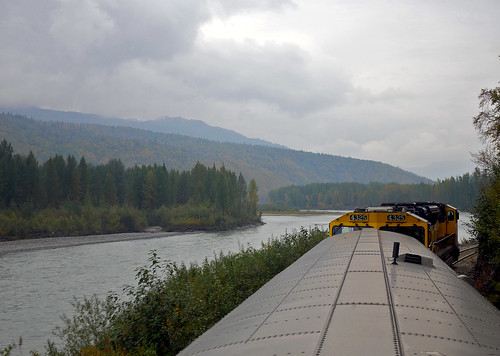 The railroad in Alaska was built in response to the Gold Rush, and a wealth of other minerals being prospected in the interior at the time. Completed in 1923, it’s 470 route miles (760-km) connected the ice free port at Seward with Fairbanks in the north. Building it wasn’t without its challenges – unstable soil, landslides, permafrost, and of course, Alaska’s frigid winters. The route necessitated some striking bridges too; the highest of which, at 296 feet, spans Hurricane Gulch. Not long after that vertigo-inducing crossing, the Alaska Range, home to the loftiest peaks in North America, appears to our west. By milepost 326, we’re joined on our east by the Nenana River, whose course we’ll follow for several miles north. Every one of those glorious sights, I should add, best appreciated from the upper level viewing platform – the single biggest perk of traveling Goldstar.
The railroad in Alaska was built in response to the Gold Rush, and a wealth of other minerals being prospected in the interior at the time. Completed in 1923, it’s 470 route miles (760-km) connected the ice free port at Seward with Fairbanks in the north. Building it wasn’t without its challenges – unstable soil, landslides, permafrost, and of course, Alaska’s frigid winters. The route necessitated some striking bridges too; the highest of which, at 296 feet, spans Hurricane Gulch. Not long after that vertigo-inducing crossing, the Alaska Range, home to the loftiest peaks in North America, appears to our west. By milepost 326, we’re joined on our east by the Nenana River, whose course we’ll follow for several miles north. Every one of those glorious sights, I should add, best appreciated from the upper level viewing platform – the single biggest perk of traveling Goldstar. Cabins at Denali, where I’m staying for two nights, lies at the eastern edge of Denali National Park, across from the Nenana River. Its definitely the closest property to the park’s boundary, but unlike a majority of the accommodation options located further up the road, it offers no courtesy shuttle whatsoever. So after a fairly long trudge from the park’s visitor center, I drop my bags off, then head out again in search of food.
Cabins at Denali, where I’m staying for two nights, lies at the eastern edge of Denali National Park, across from the Nenana River. Its definitely the closest property to the park’s boundary, but unlike a majority of the accommodation options located further up the road, it offers no courtesy shuttle whatsoever. So after a fairly long trudge from the park’s visitor center, I drop my bags off, then head out again in search of food.
The seasonal settlement of “The Canyon” boasts lodging options to suit practically every budget, with chalets, lodges and motels lining both sides of Alaska Route 3 or the George Parks Highway, and curio shops, backcountry outfitters, and a dozen or so eateries making up the rest of the habitat here. I settle on Prospectors Pizzeria and Alehouse, which, amongst other things, has 49 brews on tap, in keeping with the “49th State” theme that Alaskans wear as a badge of honor. The Chinook, featuring Alaskan Smoked Salmon and dill cream cheese, certainly hits the spot, and the “cub size” pizza is large enough for me to take leftovers back. This far north, there’s still a reasonable amount of light remaining by the time I’m back at my cabin, and judging by the cloud cover outside, I decide against staying up much longer for the Northern Lights.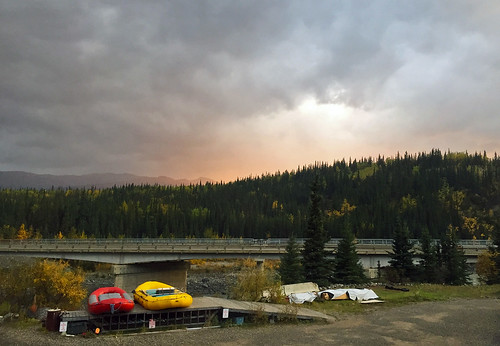 Run when you see a Moose. Play dead when you encounter a Bear. Keep a minimum distance of 25-yards for all other wildlife. All very well in theory, but when push comes to shove, I’m pretty certain none of this guidance would hold up in reality. And so, at the loudest volume possible, I have a make-believe conversation with myself, clear my throat from time to time, and walk as fast as my legs will carry me. I have 1.6 miles (2.5 km) to cover on trails swarming with the above mentioned creatures, and the sun is yet to rise. Not since that time in Bhutan, over two decades ago, when I lost my way in the forest and was separated from my group, have I been this terrified of my surroundings…
Run when you see a Moose. Play dead when you encounter a Bear. Keep a minimum distance of 25-yards for all other wildlife. All very well in theory, but when push comes to shove, I’m pretty certain none of this guidance would hold up in reality. And so, at the loudest volume possible, I have a make-believe conversation with myself, clear my throat from time to time, and walk as fast as my legs will carry me. I have 1.6 miles (2.5 km) to cover on trails swarming with the above mentioned creatures, and the sun is yet to rise. Not since that time in Bhutan, over two decades ago, when I lost my way in the forest and was separated from my group, have I been this terrified of my surroundings… Charles Sheldon came to Alaska in 1906 with the intent to hunt Dall Sheep. He left some months later with a very different vision – to lobby the US Congress to create a refuge for that very animal. In doing so, he was instrumental in the creation of Mount McKinley National Park, some years later. The park has changed names since, and its acreage significantly expanded to over six million acres today, making it larger than the entire state of New Hampshire. Had the father of Denali National Park been around today, he’d be an incredibly proud man.
Charles Sheldon came to Alaska in 1906 with the intent to hunt Dall Sheep. He left some months later with a very different vision – to lobby the US Congress to create a refuge for that very animal. In doing so, he was instrumental in the creation of Mount McKinley National Park, some years later. The park has changed names since, and its acreage significantly expanded to over six million acres today, making it larger than the entire state of New Hampshire. Had the father of Denali National Park been around today, he’d be an incredibly proud man.
I’m on a 7 am transit bus out of the Denali Bus Depot – hence the very early start for me – and Ryan is our driver this morning. While this is not technically a narrated trip, Ryan is incredibly knowledgeable and passionate, and provides us interesting tidbits about the park and the area’s wildlife from time to time. No Dall Sheep likely to be spotted at our current elevation, he assures us, but soon enough, we pull over to the side of the Park Road. Ryan points in the direction of a male Caribou or Reindeer, seated rather majestically amongst the shrub. Its our first wildlife spotting for the day, and the bus is finally awake. A single road provides access to the National Park, roughly paralleling the mighty Alaska Range for 92 miles (148 km). Fifteen miles west of the visitor center, the paved road ends, as does access for private vehicles. From that point on, one can only go further west on foot, or on one of many transit or tour buses that originate at the Denali Bus Depot. Keeping private vehicles out, and the majority of the route unpaved, was probably the most forward-thinking piece of legislation passed at the time; one that helped preserve the sanctity of the park for generations to come. As naturalist Adolph Murie said it best, “Let us be guardians, rather than gardeners.”
A single road provides access to the National Park, roughly paralleling the mighty Alaska Range for 92 miles (148 km). Fifteen miles west of the visitor center, the paved road ends, as does access for private vehicles. From that point on, one can only go further west on foot, or on one of many transit or tour buses that originate at the Denali Bus Depot. Keeping private vehicles out, and the majority of the route unpaved, was probably the most forward-thinking piece of legislation passed at the time; one that helped preserve the sanctity of the park for generations to come. As naturalist Adolph Murie said it best, “Let us be guardians, rather than gardeners.”
The tree line in Alaska, at ~3000 feet, is relatively low, and somewhere between the Teklanika River and Toklat River rest stops, we make the transition from Taiga to Tundra. At mile 48, we pull up for a brief but stunning stop at Polychrome Pass, an area that gets its name from the colorful volcanic rocks that abound here, all set to the backdrop of higher, glacier-capped mountains. At 0850 am, less than two hours after departing the bus depot, Denali is spotted, party obscured by clouds. Ryan informs us that we’re now part of the 30 percent of park visitors who get to see any semblance of the famed summit. This is, in fact, only the eighth time this entire season that he’s seen it.
At 0850 am, less than two hours after departing the bus depot, Denali is spotted, party obscured by clouds. Ryan informs us that we’re now part of the 30 percent of park visitors who get to see any semblance of the famed summit. This is, in fact, only the eighth time this entire season that he’s seen it.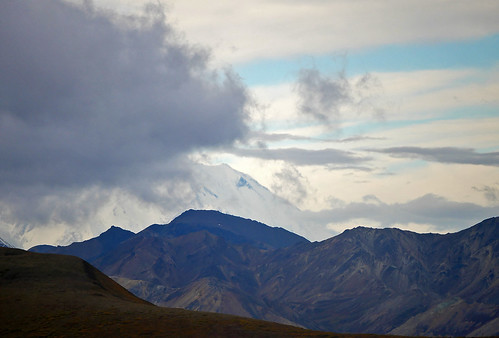 All wide awake by now, my fellow travelers are talking animatedly about just how vivid the Northern Lights were last night. One of them is passing around a perfectly crisp image of the same, taken on his smart phone, and I ask what time he saw them. 11:30, he says. Precisely an hour after I turned in. I try and contain my disappointment by focussing on the world outside.
All wide awake by now, my fellow travelers are talking animatedly about just how vivid the Northern Lights were last night. One of them is passing around a perfectly crisp image of the same, taken on his smart phone, and I ask what time he saw them. 11:30, he says. Precisely an hour after I turned in. I try and contain my disappointment by focussing on the world outside.
Black Bears outnumber Grizzlies in Denali National Park, but together, their populations are significant enough to almost guarantee a sighting or two. We’ve spotted a few already, but nothing quite as close as this pair of juvenile Grizzlies, mere feet away from the Park Road. They look quite adorable from where I’m seated presently, but this is also the closest I’d ever want to get to them, that too from the safe confines of a vehicle.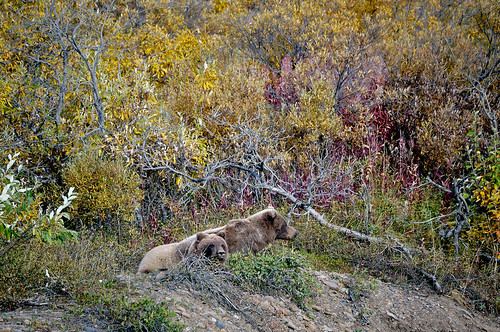 The Eielson Visitor Center, at mile 66 on the Park Road, is as far as our transit bus will take us this morning. Still a few miles out, as we round a bend in the road, there it is in all its glory – the veil of clouds having lifted entirely. The excitement in his voice now more than palpable, Ryan announces, Folks, you’re now part of an elite club – the ten percent who get to see Denali in its entirety. In Athabaskan, Denali or Denalee means “the tall one”, and at 20,310 feet (6,190 m) above sea level, not only is Denali the highest summit in North America, but topographically speaking, also the third most isolated peak after Everest and Aconcagua. Ryan is right – the sight we now behold is not one to be taken for granted. This truly is a privilege.
The Eielson Visitor Center, at mile 66 on the Park Road, is as far as our transit bus will take us this morning. Still a few miles out, as we round a bend in the road, there it is in all its glory – the veil of clouds having lifted entirely. The excitement in his voice now more than palpable, Ryan announces, Folks, you’re now part of an elite club – the ten percent who get to see Denali in its entirety. In Athabaskan, Denali or Denalee means “the tall one”, and at 20,310 feet (6,190 m) above sea level, not only is Denali the highest summit in North America, but topographically speaking, also the third most isolated peak after Everest and Aconcagua. Ryan is right – the sight we now behold is not one to be taken for granted. This truly is a privilege. Back at Denali Bus Depot, I have sufficient daylight remaining to squeeze in a hike, and of the many trails that emanate from or around the visitor center, I pick Horseshoe Lake, a 2.3 mile (3.7 km) trail that forms a loop around an oxbow lake. Hemmed in by thick boreal forests, this is an incredibly serene hike, requiring only moderate effort – ideal to start or end your day with. Its also a great primer, if you will, to the bountiful offerings that lie within Denali National Park. More a series of lakes than a single one, the distinct water bodies that make up Horseshoe Lake were created as a result of Beaver dams, and with a little bit of luck, you’ll get to see one of those fascinating creatures hard at work.
Back at Denali Bus Depot, I have sufficient daylight remaining to squeeze in a hike, and of the many trails that emanate from or around the visitor center, I pick Horseshoe Lake, a 2.3 mile (3.7 km) trail that forms a loop around an oxbow lake. Hemmed in by thick boreal forests, this is an incredibly serene hike, requiring only moderate effort – ideal to start or end your day with. Its also a great primer, if you will, to the bountiful offerings that lie within Denali National Park. More a series of lakes than a single one, the distinct water bodies that make up Horseshoe Lake were created as a result of Beaver dams, and with a little bit of luck, you’ll get to see one of those fascinating creatures hard at work. The visitor center at Denali National Park is one not to be missed. Having only stopped there briefly to pick up my park permit, upon arrival two days ago, I make it my first order of business this morning. A twenty-minute film, Heartbeats of Denali, screens at regular intervals in the auditorium here, and I time my visit so that I have at least an hour beforehand to go through the vast array of exhibits and displays; every one of them worthy of being in a top-quality museum.
The visitor center at Denali National Park is one not to be missed. Having only stopped there briefly to pick up my park permit, upon arrival two days ago, I make it my first order of business this morning. A twenty-minute film, Heartbeats of Denali, screens at regular intervals in the auditorium here, and I time my visit so that I have at least an hour beforehand to go through the vast array of exhibits and displays; every one of them worthy of being in a top-quality museum.
I have, for the longest time, regarded the National Park Service as one of the greatest institutions in the United States, and always had the utmost admiration for the men and women who manage it. And so, a Ranger-led hike was at the top of my list for this visit, but since that hasn’t worked out for a variety of reasons, I’m going to have to make do with a Ranger-led nature walk instead. The short hike turns out to be over a trail I’ve previously covered, but the little nuggets of information and wisdom gained along the way, that too from a veteran of the Service, are simply invaluable. At the very end of the walk, our Ranger leads us to a suspension bridge over Riley Creek, and asks that we all close our eyes for a minute, and just listen to our surroundings. He then leaves us with an Athabaskan quote, “We didn’t inherit this earth from our ancestors. We borrowed it from our children.” The suspension bridge forms the trail head for the Triple Lakes Trail, but if you follow the course of the creek itself, it leads to a namesake campground, the largest in the National Park. Along the way, the trail passes underneath the iconic Riley Creek Railroad Bridge. The current steel structure was manufactured in Pennsylvania, and shipped in parts via the Panama Canal, with workers eventually bridging the ~900-foot gap in the winter of 1922, replacing the wooden trestle that existed here. Someone like myself would almost certainly make the detour there, and time it just so. All quite worth it in the end, you would agree.
The suspension bridge forms the trail head for the Triple Lakes Trail, but if you follow the course of the creek itself, it leads to a namesake campground, the largest in the National Park. Along the way, the trail passes underneath the iconic Riley Creek Railroad Bridge. The current steel structure was manufactured in Pennsylvania, and shipped in parts via the Panama Canal, with workers eventually bridging the ~900-foot gap in the winter of 1922, replacing the wooden trestle that existed here. Someone like myself would almost certainly make the detour there, and time it just so. All quite worth it in the end, you would agree. About as old as the park itself, the sled dog team at Denali is the only one of its kind in the US. Packs of Alaskan Huskies patrol the park’s humongous footprint during the winter months, covering thousands of miles between them, and helping protect the very wilderness this park is renowned for. In the summer months, attending a sled dog demonstration is one of the most popular activities for visitors to the park, and following the impressive display, we’re allowed to walk around the historic kennel and meet some of those stunning creatures.
About as old as the park itself, the sled dog team at Denali is the only one of its kind in the US. Packs of Alaskan Huskies patrol the park’s humongous footprint during the winter months, covering thousands of miles between them, and helping protect the very wilderness this park is renowned for. In the summer months, attending a sled dog demonstration is one of the most popular activities for visitors to the park, and following the impressive display, we’re allowed to walk around the historic kennel and meet some of those stunning creatures.
Bred for strength and endurance rather than their appearance, these Huskies are sadly not recognized by the American Kennel Club, but they have an ardent following nevertheless. Upon retirement from the Parks Service, they’ve seldom had any trouble finding a loving home. The Canine Rangers, as they’re referred to here, number around 35 at any given time, and have the most adorable names imaginable – Cupcake, Piñata, Disco and Party, to name a few. They’re always raring to go, even when its negative 40 out, one of the Park Rangers tells me, as she engages with Summit. Our snowmobiles might have trouble starting up some mornings, but these guys, never. The northbound Denali Star departs Denali Park Station around 4 pm, and a couple of miles after leaving, we’re soaring high above Horseshoe Lake, with the many lodges that make up “the canyon” visible in the distance, dotting the hillsides. The Nenana River swings into view soon after, eventually morphing into a deep, meandering gorge. A tributary of the Tanana, which in turn is a tributary of the mighty Yukon, the Nenana forms the eastern boundary of the National Park, and both rail and road trace its course for a significant distance north. Traveling through the canyon, we also gradually move away from the Alaska Range, and into its rain shadow, the drier topography immediately evident of that. One of the toughest sections to build during the construction of the Alaska Railroad, this is also, definitively, its most spectacular. My decision to upgrade to Goldstar on this leg, having paid off handsomely.
The northbound Denali Star departs Denali Park Station around 4 pm, and a couple of miles after leaving, we’re soaring high above Horseshoe Lake, with the many lodges that make up “the canyon” visible in the distance, dotting the hillsides. The Nenana River swings into view soon after, eventually morphing into a deep, meandering gorge. A tributary of the Tanana, which in turn is a tributary of the mighty Yukon, the Nenana forms the eastern boundary of the National Park, and both rail and road trace its course for a significant distance north. Traveling through the canyon, we also gradually move away from the Alaska Range, and into its rain shadow, the drier topography immediately evident of that. One of the toughest sections to build during the construction of the Alaska Railroad, this is also, definitively, its most spectacular. My decision to upgrade to Goldstar on this leg, having paid off handsomely. Located at a latitude of 64.8°, Fairbanks is the furthest north I’ve ever been. And with only ~200 miles (322 km) separating us right now, its also the closest I’ve come to the Arctic Circle. Its so far north, my host tells me, that during the summer solstice, Fairbanks hosts a baseball match at midnight, played under natural light. And even this late in the summer, it still has an hour more of daylight than Anchorage, which is only a few hundred miles south. Its all fairly comforting to know, after I’ve just been informed by a fellow diner of another missed Aurora opportunity, mere hours ago. As difficult as that is to swallow, I tuck in to breakfast at the delightful Ah, Rose Marie B&B in downtown Fairbanks.
Located at a latitude of 64.8°, Fairbanks is the furthest north I’ve ever been. And with only ~200 miles (322 km) separating us right now, its also the closest I’ve come to the Arctic Circle. Its so far north, my host tells me, that during the summer solstice, Fairbanks hosts a baseball match at midnight, played under natural light. And even this late in the summer, it still has an hour more of daylight than Anchorage, which is only a few hundred miles south. Its all fairly comforting to know, after I’ve just been informed by a fellow diner of another missed Aurora opportunity, mere hours ago. As difficult as that is to swallow, I tuck in to breakfast at the delightful Ah, Rose Marie B&B in downtown Fairbanks. The largest city in the interior of Alaska, Fairbanks is barely over a century old. Established as a trading post in the early 1900s, it grew in importance following the Gold Rush, with the towns economy getting a real boost after the arrival of the railroad in 1923. Fairbanks is settled along the Chena River, also a tributary of the Tanana, and walking west along its course for a little over a mile brings me to Pioneer Park. Commemorating early Alaskan history, with multiple museums and historic displays, the park also features the recreation of a Gold Rush town, made up of 35 fully restored buildings from the earliest days of the settlement. Amongst them is the Kitty Hensley House, a quaint red cabin from the early 20th-century, and I’m invited in to sign the guest register here. A rather coveted entry at that – I happen to be there ten thousandth visitor.
The largest city in the interior of Alaska, Fairbanks is barely over a century old. Established as a trading post in the early 1900s, it grew in importance following the Gold Rush, with the towns economy getting a real boost after the arrival of the railroad in 1923. Fairbanks is settled along the Chena River, also a tributary of the Tanana, and walking west along its course for a little over a mile brings me to Pioneer Park. Commemorating early Alaskan history, with multiple museums and historic displays, the park also features the recreation of a Gold Rush town, made up of 35 fully restored buildings from the earliest days of the settlement. Amongst them is the Kitty Hensley House, a quaint red cabin from the early 20th-century, and I’m invited in to sign the guest register here. A rather coveted entry at that – I happen to be there ten thousandth visitor. Back in Anchorage, the rain from a few days ago has cleared things up significantly, and even though its an overcast day, there’s no smoke lingering from those wildfires, and the air quality index is back in the low double digits, where it belongs. I hit up Pablo‘s in downtown, who’s bike rental happens to be just a block away from the Tony Knowles Coastal Trail. Reputed to be one of the most scenic urban trails in the country, the 11-mile long coastal route gently winds its way along Cook Inlet, from downtown Anchorage to Kincaid Park. As I prepare to set off on my Trek hybrid, Pablo Junior says to me, watch out for those Bears and Moose…
Back in Anchorage, the rain from a few days ago has cleared things up significantly, and even though its an overcast day, there’s no smoke lingering from those wildfires, and the air quality index is back in the low double digits, where it belongs. I hit up Pablo‘s in downtown, who’s bike rental happens to be just a block away from the Tony Knowles Coastal Trail. Reputed to be one of the most scenic urban trails in the country, the 11-mile long coastal route gently winds its way along Cook Inlet, from downtown Anchorage to Kincaid Park. As I prepare to set off on my Trek hybrid, Pablo Junior says to me, watch out for those Bears and Moose… I encounter none, thankfully, and after dropping my rental off, I head off towards the 49th State Brewing Company‘s Anchorage brewpub. Alaska is home to over forty breweries, and Anchorage alone boasts of nine. This particular venue is the sister location to the brewery’s first, which, fittingly, is in the town of Healy, just outside Denali National Park. Fairly ravenous by now, I order King Crab and Avocado on toast, and a celebratory pint of their deliciously crisp Vagabond Saison; a last hurrah before heading back to the “lower 48”.
I encounter none, thankfully, and after dropping my rental off, I head off towards the 49th State Brewing Company‘s Anchorage brewpub. Alaska is home to over forty breweries, and Anchorage alone boasts of nine. This particular venue is the sister location to the brewery’s first, which, fittingly, is in the town of Healy, just outside Denali National Park. Fairly ravenous by now, I order King Crab and Avocado on toast, and a celebratory pint of their deliciously crisp Vagabond Saison; a last hurrah before heading back to the “lower 48”.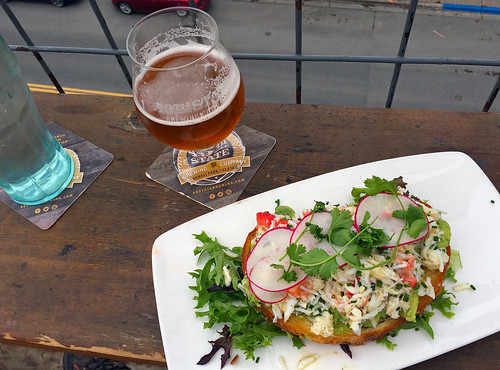
A full set of photos from my journey on the Denali Star and time spent in Alaska can be seen on my Flickr.
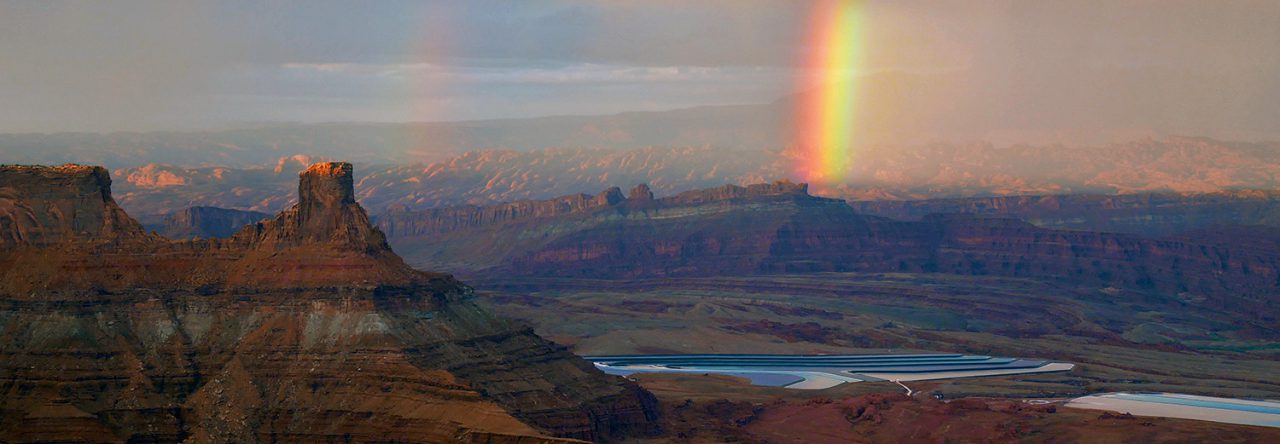
This looks like such an incredible trip. I especially appreciated the pizza mention — I never would have thought to put salmon on a pizza, but now I’m going to try it! Cheers.